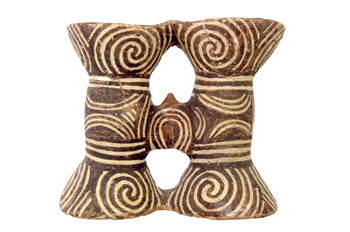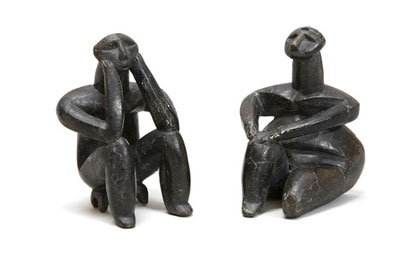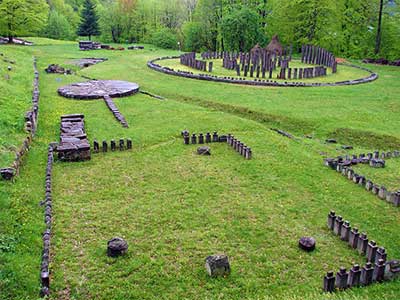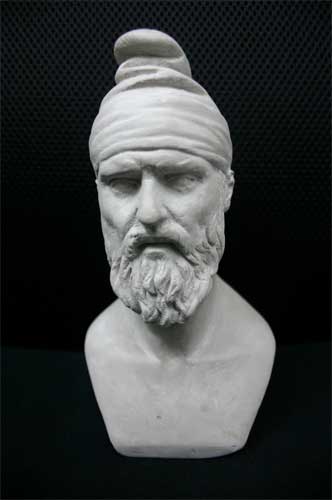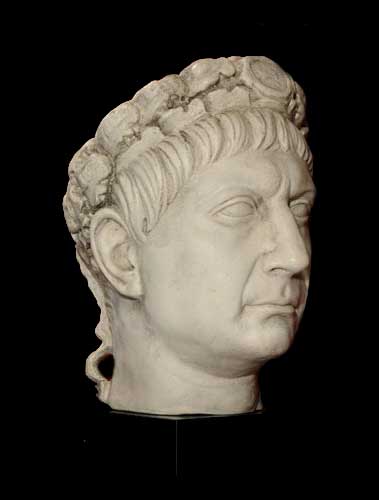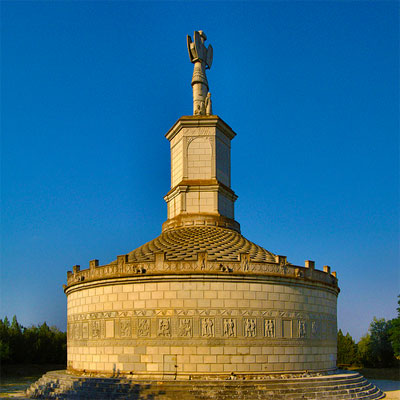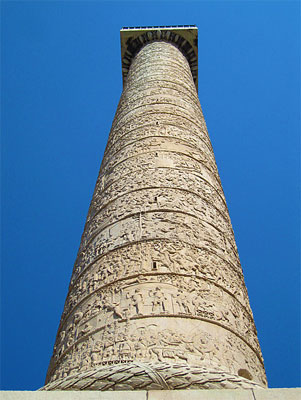The History of Romania
Part 1: Romans, Dacians and Getae
Romania is situated in Central Europe, in the northern part of the Balkan peninsula and its territory is marked by the Carpathian Mountains, the Danube and the Black Sea. With its temperate climate and varied natural environment, which is favourable to life, the Romanian territory has been inhabited since time immemorial. The research done by Romanian archaeologists at Bugiulesti, Valcea Country, has led to the discovery of traces of human presence dating back as early as the Lower Palaeolithic (approximately two million years BC). These vestiges are among the oldest in Europe, revealing a period when 'man,' a humanoid in fact, went physically and spiritually through the stages of his coming out of the animal status. A denser human population, ('the Neanderthal man') can be proved to have lived about 100,000 years ago; a relatively stable population can only be found beginning with the Neolithic (6-5,000 years BC).
|
Cucuteni pottery |
At the time, the population on the territory of present-day Romania created a remarkable culture, whose proof is the polychrome pottery of the 'Cucuteni' culture (comparable to the pottery of other important European cultures of the time in the Eastern Mediterranean and the Middle East) and the statuettes of the 'Hamangia' culture (the Thinker of Hamangia is known today to the whole world).
|
The Thinkers of Hamangia (Neolithic statuette) |
At the turn of the second millennium, when the Palaeolithic age made way for the Bronze age, the Thracian tribes of Indo-European origin settled alongside the population that already lived in the Carpathian-Balkan region. From the time of the Thracians on, the uninterrupted phenomenon of the Romanian people's birth can be traced. In the former half of the first millennium BC, in the Carpathian-Danube-Pontic area - which was the northern part of the large surface inhabited by the Thracian tribes - a northern Thracian group became individualised: it was made up of a mosaic of Getae and Dacian tribes. Strabo, a famous geographer and historian in the age of emperor Augustus, informs that 'the Dacians have the same language as the Getae.' Basically, it was the same people, the only difference between the Dacians and the Getae being the area they inhabited: the Dacians - mostly in the mountains and the plateau of Transylvania; the Getae - in the Danube Plains. In the Antiquity, the Greeks, who first got to encounter the Getae - used this name for the whole population north of the Danube, while the Romans, who first got to encounter the Dacians-extended this name to cover all the other tribes on the present-day territory of Romania; after the conquest of this territory, the Romans created here the Dacia province. This is why the whole territory of present-day Romania is called Dacia in all ancient Latin and Early Middle Ages sources.
The contact of the Geto-Dacians with the Greek world was made easy by the Greek colonies created on the present-day Romanian Black Sea shore: Istros (Histria), founded in the 7th century BC, Callatis (today: Mangalia) and Tomi (today: Constanta); the latter two were founded a century later. In the recorded history, the population north of the Danube (the Getae) was first mentioned by Herodotus, 'the father of history' (the 4th century BC). He told the story of the campaign of Persian king Darius I against the Scythians in the northern Pontic steppes (513 BC). He wrote that the Getae were 'the most valiant and just of the Thracians'. They had been the only ones to resist the Persian king on the way from the Bosporus to the Danube.
Burebista (82 - around 44 BC), who succeeded to unite the Geto-Dacian tribes for the first time, founded a powerful kingdom that stretched, when the Dacian sovereign offered to support Pompey against Caesar (48 BC), from the Beskids (north), the Middle Danube (west), the Tyras river (the Dniester), and the Black Sea shore (east) to the Balkan Mountains (south).
|
The Dacian stronghold of Sarmisegetuza |
In the 1st century BC, as the Roman empire was expanding and Roman provinces were being created in Pannonia, Dalmatia, Moesia and Thracia, the Danube became, along 1,500 Km., the border between the Roman Empire and the Dacian world. In Dobrudja, which was under Roman rule for seven centuries beginning with the reign of Augustus, poet Publius Ovidius Naso spent the last years of his life, 'among Greeks and Getae,' as he was exiled there, to Tomi (8-17, AD) by order of the same Caesar.
Dacia was at the peak of its power under King Decebal (87-106 AD). After a first confrontation during the reign of Domitian (87-89), two extremely tough wars were necessary (101-102 and 105-106) to the Roman empire, at the peak of its power under Emperor Trajan (98-117) to defeat Decebal and turn most of his kingdom into the Roman province called Dacia.
|
|
King Decebal |
Emperor Trajan |
|
The Roman monument of Adam Clisi |
Trajan's Column erected in Rome and the Triumphal Monument at Adamclisi (Dobrudja) tell the story of this military effort, which was followed by a systematic and massive colonisation of the new territories that were integrated into the empire.
The Dacians, although they had suffered heavy casuals, remained, even after the new rule was established, the main ethnic element in Dacia; the province was subjected to a complex Romanization process, its basic element being the staged but definitive adoption of the Latin language.
The Romanians are today the only descendants of the Eastern Roman stock; the Romanian language is one of the major heirs of the Latin language, together with French, Italian, Spanish; Romania is an oasis of Latinity in this part of Europe.
|
Trajan's Column in Rome |
The natives, be they of Roman or Daco-Roman descent, continued their uninterrupted existence as farmers and shepherds even after the withdrawal, under emperor Aurelian (270-275) of the Roman army and administration, which were moved south of the Danube. But the ancestors of the Romanians remained for several centuries in the political, economic, religious and cultural sphere of influence of the Roman Empire; after the empire split in 395 AD, they stayed in the sphere of the Byzantine Empire. They lived mostly in the old Roman hearts that had now decayed and survived in difficult circumstances under successive waves of migratory tribes.
At the time when the Daco-Roman ethno-cultural symbiosis was achieved and finalised in the 6-7th centuries by the formation of the Romanian people, in the 2-4th centuries, the Daco-Romans adopted Christianity in a Latin garb. Therefore, in the 6-7th centuries, when the formation process of the Romanian people was done, this nation emerged in history as a Christian one. This is why, unlike the neighbouring nations, which have established dates of Christianization (the Bulgarians - 865, the Serbs - 874, the Poles-966, the eastern Slavs - 988, the Hungarians - the year 1000), the Romanians do not have a fixed date of Christianization, as they were the first Christian nation in the region.
In the 4-13th centuries the Romanian people had to face the waves of migrating peoples - the Getae, the Huns, the Gepidae, the Avars, the Slavs, the Petchenegs, the Cumanians, the Tartars - who crossed the Romanian territory. The migratory tribes controlled this space from the military and political points of view, delaying the economic and social development of the natives and the formation of local statehood entities.
The Slavs, who massively settled since the 7th century south of the Danube, split the compact mass of Romanians in the Carpathian-Danubian area: the ones to the north (the Daco-Romanians) were separated from the ones to the south, who were moved towards the west and Southeast of the Balkan Peninsula (Aromanians, Megleno-Romanians and Istro-Romanians). The Slavs that settled north of the Danube were assimilated little by little by the Romanian people and their language left traces in the vocabulary and phonetics of the Romanian language. To the Romanian language, the Slavic language (similarly to the Germanic idiom of the Franks with the French people) was the so-called super-imposed layer. The Romanians belonged to the Orthodox religion so they adopted the Old Church Slavic as a cult language, and, beginning with the 14-16th centuries, as a chancery and culture language. The Slavic language was never a living language, spoken by the people, on the territory of Romania; it played for Romanians, at a certain time during the Middle Ages, the same role that Latin played in the West; in the early modern age it was replaced for ever, in church, chancery and culture included, by the Romanian language. Owing to their position, the Romanians south of the Danube were the first to be mentioned in historical sources (the 10th century), under the name of vlahi or blahi (Wallachians); this name shows they were speakers of a Romance language and that the non-Roman peoples around them recognised this fact. After the year 602, the Slavs massively settled south of the Danube and they established a powerful Bulgarian czardom in the 9th century; this, cut the tie between the Romanian world north of the Danube and the one south of the Danube. As they were subjected to all sorts of pressures and isolated from the powerful Romanian trunk north of the Danube, the number of Romanians south of the Danube continuously decreased, while their brothers north of the Danube, although living in extremely difficult circumstances, continued their historical evolution as a separate nation, the farthest one to the east among the descendants of Imperial Rome.
In fact the Romanians are the only ones who, through their very name - roman - (coming from the Latin word 'Roman') - have preserved to this day in this part of Europe the seal of the ancestors, of their descent, that they have always been aware of. This will show later in the name of the nation state - Romania.

